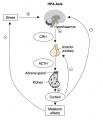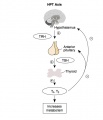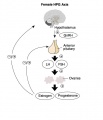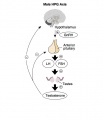Template:HPA axis: Difference between revisions
No edit summary |
mNo edit summary |
||
| (One intermediate revision by the same user not shown) | |||
| Line 1: | Line 1: | ||
:'''Links | :[[Endocrine System Development|'''Links''']]: [[:File:HPA_axis.jpg|Image - HPA]] | [[Endocrine - Hypothalamus Development|Hypothalamus]] | [[Endocrine - Pituitary Development|Pituitary]] | [[Endocrine - Adrenal Development|Adrenal]] | [[:File:HPT_axis.jpg|Image - HPT Axis]] | [[Endocrine - Thyroid Development|Thyroid]] | [[:File:HPG_female_axis.jpg|Image - HPG female]] | [[:File:HPG_male_axis.jpg|Image - HPG male]] | [[Endocrine - Gonad Development|Gonad]] | ||
<gallery> | <gallery> | ||
| Line 11: | Line 11: | ||
The hypothalamus is a small region located within the brain that controls many bodily functions, including eating and drinking, sexual functions and behaviors, blood pressure and heart rate, body temperature maintenance, the sleep-wake cycle, and emotional states (e.g., fear, pain, anger, and pleasure). Hypothalamic hormones play pivotal roles in the regulation of many of those functions. Because the hypothalamus is part of the central nervous system, the hypothalamic hormones actually are produced by nerve cells (i.e., neurons). | The hypothalamus is a small region located within the brain that controls many bodily functions, including eating and drinking, sexual functions and behaviors, blood pressure and heart rate, body temperature maintenance, the sleep-wake cycle, and emotional states (e.g., fear, pain, anger, and pleasure). Hypothalamic hormones play pivotal roles in the regulation of many of those functions. Because the hypothalamus is part of the central nervous system, the hypothalamic hormones actually are produced by nerve cells (i.e., neurons). | ||
[[Endocrine - Hypothalamus Development|Hypothalamus]] | |||
===Pituitary=== | ===Pituitary=== | ||
The anterior pituitary produces several important hormones that either stimulate target glands (e.g., the adrenal glands, gonads, or thyroid gland) to produce target gland hormones or directly affect target organs. The pituitary hormones include adreno- corticotropic hormone (ACTH); gonadotropins; thyroid-stimulating hormone (TSH), also called thyrotropin; growth hormone (GH); and prolactin. | The anterior pituitary produces several important hormones that either stimulate target glands (e.g., the adrenal glands, gonads, or thyroid gland) to produce target gland hormones or directly affect target organs. The pituitary hormones include adreno-corticotropic hormone (ACTH); gonadotropins; thyroid-stimulating hormone (TSH), also called thyrotropin; growth hormone (GH); and prolactin. | ||
The first three of those hormones (ACTH, gonadotropins, and TSH) act on other glands. | |||
* ACTH stimulates the adrenal cortex to produce corticosteroid hormones (primarily cortisol) as well as small amounts of female and male sex hormones. | |||
* Gonadotropins comprise two molecules, luteinizing hormone (LH) and follicle-stimulating hormone (FSH). These two hormones regulate the production of female and male sex hormones in the ovaries and testes as well as the production of the germ cells (oocyte and spermatozoa). | |||
* TSH stimulates the thyroid gland to produce and release thyroid hormone. | |||
The remaining two pituitary hormones, GH and prolactin, directly affect their target organs. | |||
[[Endocrine - Pituitary Development|Pituitary]] | |||
Latest revision as of 10:09, 3 September 2015
- Links: Image - HPA | Hypothalamus | Pituitary | Adrenal | Image - HPT Axis | Thyroid | Image - HPG female | Image - HPG male | Gonad
Hypothalamus
The hypothalamus is a small region located within the brain that controls many bodily functions, including eating and drinking, sexual functions and behaviors, blood pressure and heart rate, body temperature maintenance, the sleep-wake cycle, and emotional states (e.g., fear, pain, anger, and pleasure). Hypothalamic hormones play pivotal roles in the regulation of many of those functions. Because the hypothalamus is part of the central nervous system, the hypothalamic hormones actually are produced by nerve cells (i.e., neurons).
Pituitary
The anterior pituitary produces several important hormones that either stimulate target glands (e.g., the adrenal glands, gonads, or thyroid gland) to produce target gland hormones or directly affect target organs. The pituitary hormones include adreno-corticotropic hormone (ACTH); gonadotropins; thyroid-stimulating hormone (TSH), also called thyrotropin; growth hormone (GH); and prolactin.
The first three of those hormones (ACTH, gonadotropins, and TSH) act on other glands.
- ACTH stimulates the adrenal cortex to produce corticosteroid hormones (primarily cortisol) as well as small amounts of female and male sex hormones.
- Gonadotropins comprise two molecules, luteinizing hormone (LH) and follicle-stimulating hormone (FSH). These two hormones regulate the production of female and male sex hormones in the ovaries and testes as well as the production of the germ cells (oocyte and spermatozoa).
- TSH stimulates the thyroid gland to produce and release thyroid hormone.
The remaining two pituitary hormones, GH and prolactin, directly affect their target organs.



